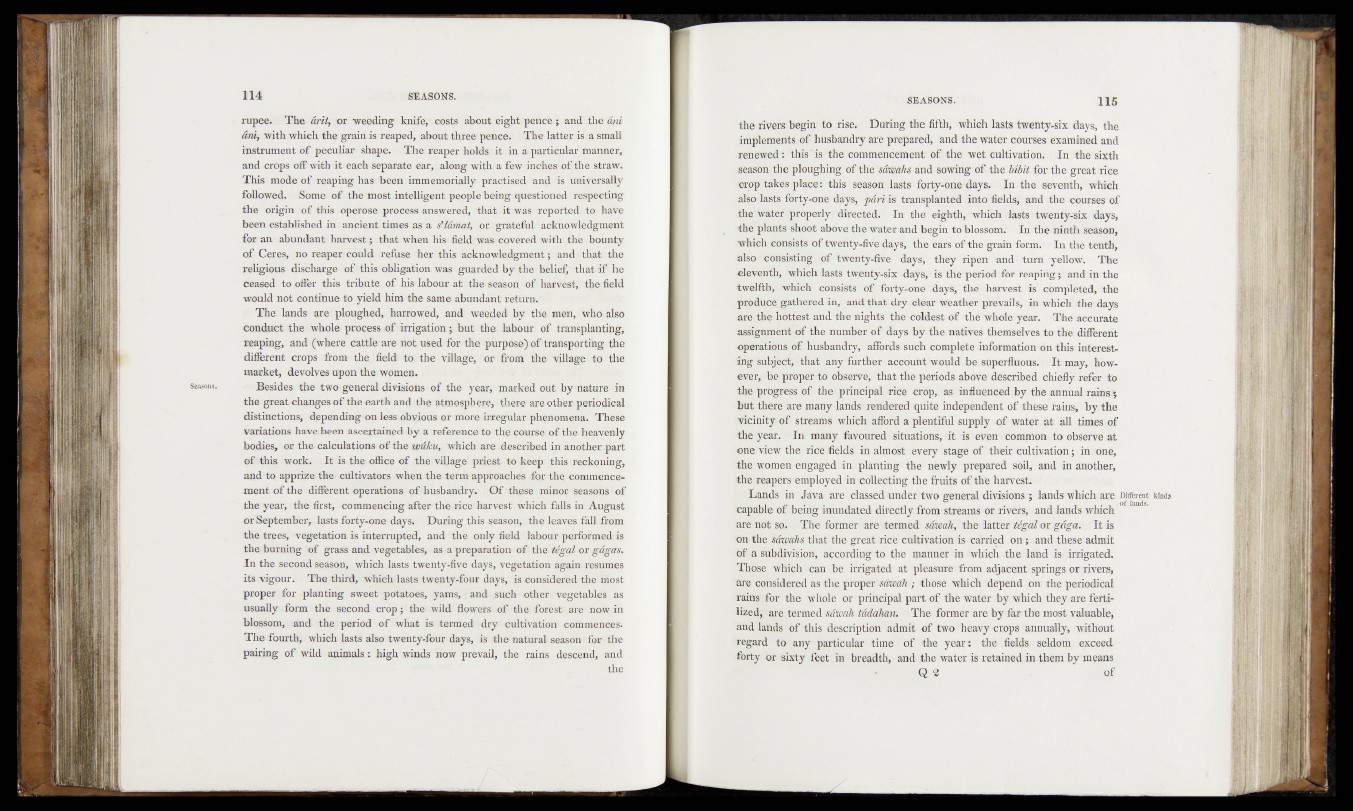
rupee. The arvi, or weeding knife, costs about eight pence ; and the ani
dni) with whichthe grain is reaped), about three pence. The latterisa small
instrument of peculiar shape. The reaper holds. -it in a particular manner,
and crops off with it eaasb separate ear, along with a few inches* of the straw.
This mode of reaping has been immemorial^ practised and i-s universally
followed. Some of the most intelligent people being questioned respecting
the origin of this operose process answered, that it was reported, to have
been established in ancient times as a dlamatt or grateful acknowledgment
for* an abundant harvest 5 *that when Ms-field was covered wii&V’ftjiiJ bounty
of Ceres, no reaper could refuse her this acknowledgment; and that the
religious discharge of this obligation was guarded by the belief thfit ifThe
ceased to offer this tribute of Ms labour eft the season, oft harvest, the field
would not continue to yield him the same abundant return.
The- lands p e ploughed, harrowed, and . weeded by the* men, who also
conduct the whole process of irrigation; but the labour' of transplanting,
reaping, and. (where cattle* are not used for the purpose) of transporting the
different crops from the. field to the village, or from the- village to the
market, devolves upon the women.
Seasons. - Besides the two-general divisions of the year; marked out-by nature* in
the great changes of the earth and the atmosphere, there are-other- periodical
distinctions, depending on* less obvious or mese. irregular phenomena. These
variations have.heen asoertainpd by a reference* to the course of. the heavenly
bodies, or the- calculations of the* ipiiku, which are described in another .part
of this work. I t is the office of the village priest to keep this- reckoning,
and to apprize the cultivators when the term approaches .for the commencement
of the different operations of husbandry* Of these -minor seasons of
the year, the first, commencing after* the*:ii®;barvest Which MM in August
or September,- lasts forty-one days* During this season, the leaves fall from
the trees, vegetation is interrupted, and the only field labour performed is
the burning of grass and vegetables, as a preparation of 'the Ugal QZ g&gas*
In the second season, which lasts twenty-five days, vegetation again resumes
its vigour. The third, which lasts twenty-four days, is considered the* Most
proper for planting sweet potatoes, yams, and such other vegetables as
usually form the second crop; the- wild flowers of the forestr are now in
blossom, and the period* of wfiaft is teamed dry cultivation- comesnees.
The fourth, which* lasts also twenty-four- days, -is the natural season for the
pairing of wild animals: high winds now prevail, the rains descend, and
'the
the riyers-begin to rise.- ^During the fifth, which lasts twenty-six days, the '
implements of husbandly are prepared» and thewater courses examined and
renewed t this“ïs*rthe commencement of the wet wltivaiioniSSn the sixth
season- tkeyplöüghing'ol^the sowing/Off the‘MMtJkk the great rice
crop takes placed this1 Season:lasts '-forty*‘böè'days* - In the seventh, which
also lasts forty-one days, lp'âfi‘4s transplanted -into ’fields, and -the 'courses of
the watef pfopeïly- directe dP In -'th# eighth» which lasts twenty-six days,
the plants:shoot abbve the wateratid foegin'4© blossom*.1 in the ninth season,
Which consists of twen'ty-fftfedays, the ears ofkfctfe grain formu In the tenth,
«also consisting • öfo twënty-five days-,' they ripen land turn yfellow. The
eleventh, which lasts twenty-six days, is thé petiod‘.fef reaping; and in the
twelfth, which consists of 'forfcy-onfe ■ days, 'the harvest ïs cbmpleted, thfe
produce, gathered in,-and thatdry-clear Weather -prevails, in which -the days
are thé hôtfest and the nights the coldest of the Whole year. The accurate
assignment of the-number of days7by file natives themselves tothe different
operations of husbandly, affords such complete information on this interesting
subject,'-that any further account Would .‘be superfluous. It may, however,'
be proper to Observe, that the periods- above described chiefly refer to
the progress of/the principal ’rice crop, as influenced jby the annual rains';
but there are many-lands rendered quite independent ofiitfafese rains, by-the
vicinity of' streams which afford a plentiful supply of water at all times of
fhtyeari-- In many favoured situations, I t -is'even common to observe at
on® view the rice fields* in almost every stage of their cultivation.; in one,
the women engaged -in ' planting the newly prepared soil, and in another,
the reapers employed in collecting the fruits of the harvest.
Lands in Java are classed under two general divisions ; lands which are nifferent kinds
capable of being inundated directly from streams ortriver% and lands Which
are not so. The former are termed sâwah, the latter têgul ox '•gâ^eu > . It fe
on the that the great ride cultivation is carried bn ; and these admit
of à subdivision, according to the manner in which *,the land is irrigated.
Those which can be irrigated' at pleasure from adjacent springs or rivers,
are considered as the proper Mrwuh / those Which depend, on the periodical
raitt's for the whole or principal part of the Water by which they are fertilized,
are termed sètoah tadahtm. The former are by far the most valuable,
and lands of this -description admit of two heavy crops annually, without
regard to- any particular time of the year : the fields seldom exceed
forty or sixty feet in breadth, and the water is retained in them by means
m m m m |H